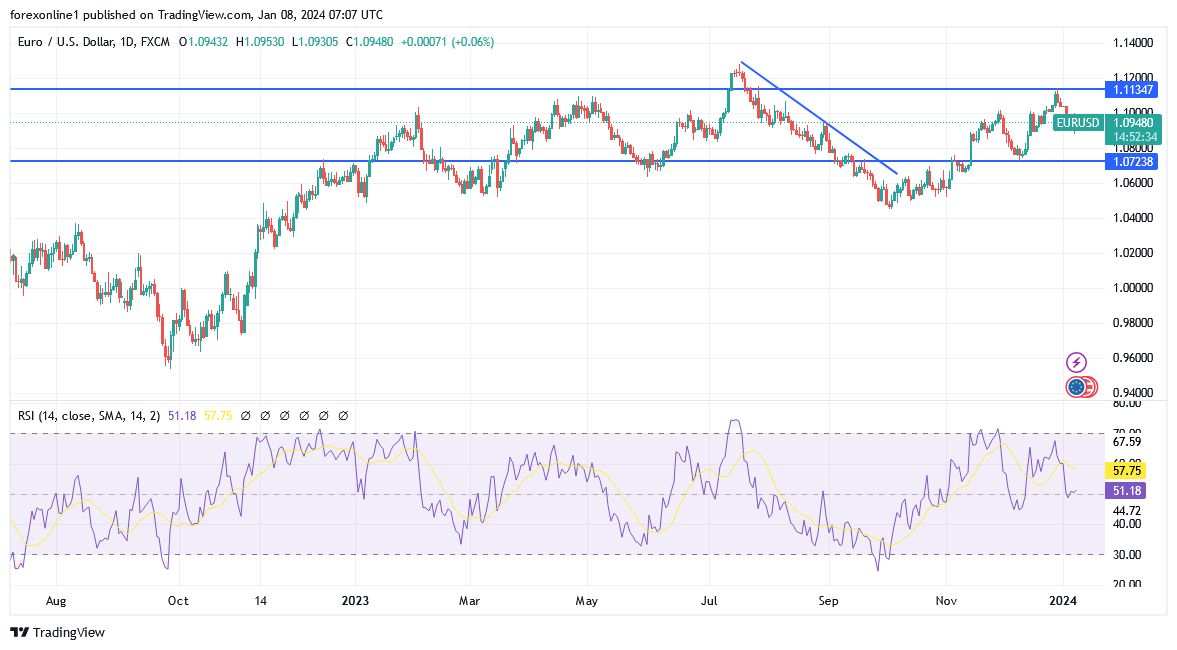The US dollar was unable to make any headway against European currencies on Thursday, but it did record a brief net gain after stronger-than-expected US employment data. Following the US data, the euro fell to the support level of 1.0876 but managed to close last week's trading around 1.0940, which is the level it is trading around at the time of writing. Selling was limited as stocks resisted major selling.

Recenty, the latest ADP data recorded an increase in US private sector salaries of 164,000 for the month of December, compared to consensus expectations of 115,000 and after a downwardly revised 101,000 in the previous month. According to the ADP report, last month saw moderate growth in US employment and another slowdown in wage gains. Both goods and services were weak, with leisure, hospitality and manufacturing falling. Regarding wages, the annual increase slowed further to 5.4% from 5.6%, the lowest figure since August 2021. Meanwhile, ADP chief economist Neela Richardson commented: “We are returning to a Labor market that is largely in line with pre-pandemic employment.” She added; “Although wages were not the cause of the recent bout of inflation, now that wage growth has subsided, any risk of a wage and price spiral has disappeared.”
Given the impact on inflation, the US Federal Reserve would welcome further easing of wage pressures. Thus, initial jobless claims fell to 202,000 in the final week from a revised 220,000 the previous week and below consensus expectations of 216,000. Also, Continuing claims fell to 1.86 million from 1.89 million the previous week. Although the US Federal Reserve will take some comfort from the wage data, the overall Labor market data is unlikely to stimulate any talk of an early cut in interest rates within the US central bank.
Following the data, Treasury yields lost ground with the 10-year bond yield rising to nearly 4.00%. moreover, financial markets were still anticipating a roughly 65% chance of a rate cut at the March policy meeting. However, higher yields were important in providing support to the dollar in global markets.
Also, General risk conditions will be important for currency markets. According to ING Bank, “selling the US dollar has once again become more expensive with 10-year Treasury yields once again approaching 4.0%. Therefore, the dominance of equities/global risk sentiment as drivers of FX markets means that the dollar’s dynamics remain strictly linked to the markets’ reassessment of levels.” Stock market “.
Furthermore, the US dollar tends to strengthen against European currencies if stocks are under pressure. Generally, Stock markets saw no significant change after the US data, but Wall Street indicators will be closely monitored.
Over and above that, Geopolitical developments are also likely to be important in the short term. Markets will be monitoring developments in the Middle East with a particular focus on oil prices. In addition to reducing the likelihood of an interest rate cut by the Fed, higher oil prices may also undermine confidence in the eurozone economy. Finally, It is expected that easing core inflation in the United States will enhance the US Federal Reserve's optimism.
Top Forex Brokers
Technical Analysis of the EUR/USD:
According to the performance on the daily timeframe chart above, if the price of the Euro against the US Dollar (EUR/USD) moves below the level of 1.1000, it will increase the chances for bears to further downward movement. Currently, the nearest support levels are 1.0880 and 1.0790, with the latter being sufficient to push technical indicators towards strong oversold levels. On the other hand, within the same timeframe, bulls must return to the vicinity of resistance levels at 1.1030 and 1.1100 to change the current bearish outlook. Shortly, the EUR/USD will remain on its current path until the markets react to the announcement of US inflation figures this week.
Ready to trade our daily Forex forecast? Here’s a list of some of the best regulated forex brokers to check out.
